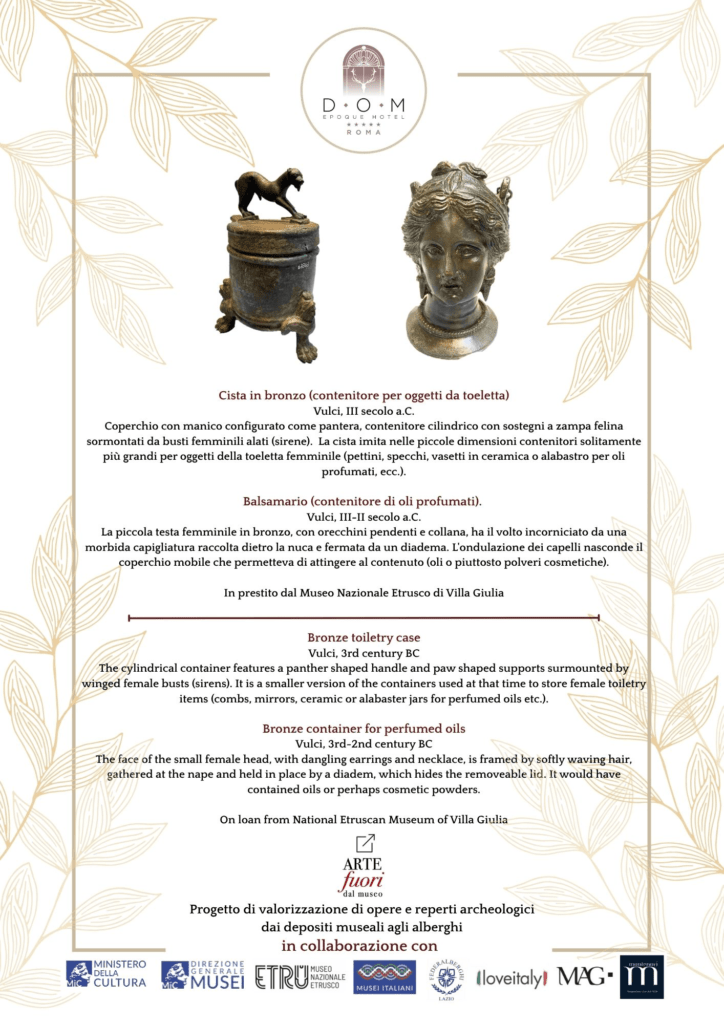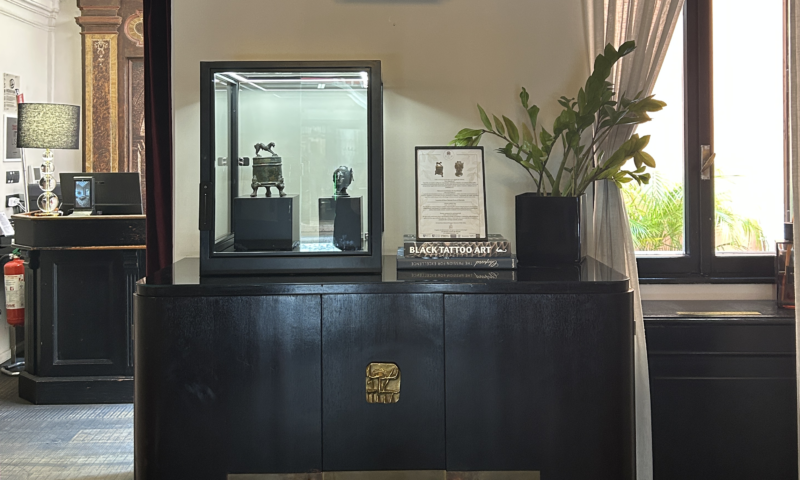Press Release – 17 June 2025, Rome
A new initiative has been added to the “Art Out Of the Museum” program, promoted by the Directorate General of Museums together with LoveItaly and Federalberghi Lazio
National Etruscan Museum of Villa Giulia & Hotel Dom
Etruscan masterpieces emerge from storage to meet the city:
two bronze works on display at Hotel DOM, thanks to “Art Out Of the Museum”
The latest addition to “Art Out Of the Museum” is the exhibition of two valuable bronze works from the National Etruscan Museum of Villa Giulia (Rome): an elegant cista and a balsamarium in the shape of a woman’s head, dating back to the 3rd century BC and originating from two different tombs in the Osteria di Vulci necropolis.
“Our project to bring the Museum outside the Museum continues: Villa Giulia is already in airports and now also in hotels, thanks to an agreement signed between the Directorate General of Museums and Federalberghi,” notes Luana Toniolo, Director of the National Etruscan Museum of Villa Giulia. “This is a great opportunity, on the one hand, to protect and enhance the immense heritage we preserve in storage—which, as the pieces on display here clearly attest, is by no means made up of minor artifacts—and, on the other, to make our museum known to an ever-wider audience. We are delighted that the National Etruscan Museum of Villa Giulia is part of this project, which we hope will bring the public ever closer to our history and our roots, in the elegant and refined setting of the capital’s historic hotels.”
After careful restoration, the two artifacts will temporarily leave the museum storage rooms for display at Hotel DOM in Via Giulia; the hotel has enthusiastically embraced the initiative, helping to highlight the profound connection between hospitality and culture. The display will run until June 10, 2026.
Two works, two stories to rediscover
The cista, a container used to store women’s toiletries, and the balsamarium, featuring an elegant female head, used for oils and perfumes, offer a glimpse into the daily lives of women and their care for their image in Etruscan society which, unlike the Greeks and Romans, held women in high regard. These small but significant objects reveal the most intimate and sophisticated facet of Etruscan civilization.
“The restoration of the small cista and the bronze balsamarium,” explains Miriam Lamonaca, Head of the Museum’s Conservation Service, “offered us an important learning process: we took a methodological approach based on a historical, material, and technological analysis of the artifacts. This project not only guarantees the long-term conservation of the materials, but also improved the readability of the scenes depicted on the cistawithout altering their identity.”
“We are honored to collaborate with the National Etruscan Museum of Villa Giulia,” reiterates Stefano Pighini, Vice President of LoveItaly, “in this, the second iteration of ‘Art Outside the Museum’. The first display was inaugurated last October. Our goal is to enhance and raise the profile of Italy’s extraordinary museum scene through these temporary exhibitions, of which 15 are currently being prepared.”
Art Out Of the Museum
The exhibition, strongly supported by Paolo Amabile, Head of Strategic Management at Hotel DOM, is part of the broader “Art Out Of the Museum” program, promoted by the Directorate General of Museums of the Ministry of Culture, LoveItaly, and Federalberghi Lazio.
The goal is to bring to light works in the storage rooms of Italian museums through restoration and display in unusual but safe locations, accessible to the general public, such as hotels of historical and architectural value, which cover the costs of the necessary conservation work.
Hotel DOM, a refined establishment in a 17th-century building in the heart of Via Giulia, was selected for its historical significance and attention to detail, as well as for its commitment to promoting culture in the area.
The project is the result of the synergy between public institutions, museums, non-profit associations, and private tourism operators. Insurance coverage for the works, from transport to exhibition, is guaranteed by MAG Italia, a long-standing Italian insurance broker active in the art and culture industry.
Thanks to the working group from the National Etruscan Museum of Villa Giulia: Valentina Belfiore, Maria Paola Guidobaldi, Miriam Lamonaca, Anna Tanzarella, Antonietta Simonelli, Pasquale De Bellis, and Stefano Frusone; De.Co.Re. s.r.l., for restoring the works; and Montenovi, for handling and transportation, for making this possible.
Visit the National Etruscan Museum of Villa Giulia, Piazzale di Villa Giulia, 9, Rome
For information: mn-etru@cultura.gov.it
Visit the display at Hotel DOM – Via Giulia 131, Roma
Email: info@domhotelroma.com



